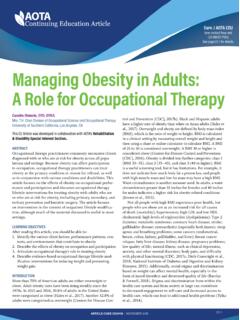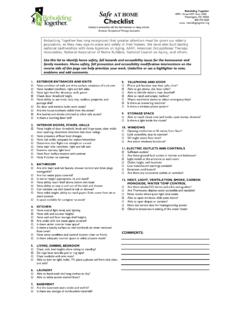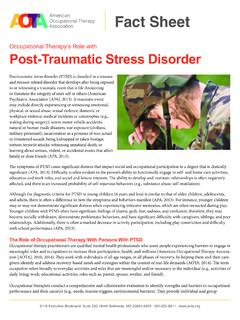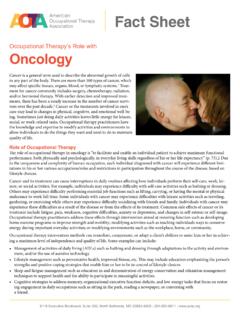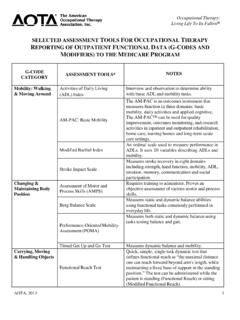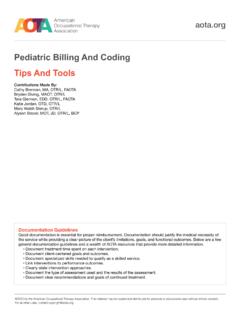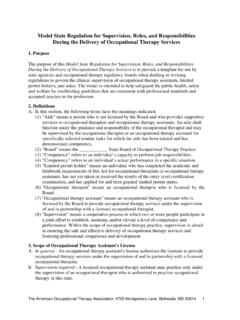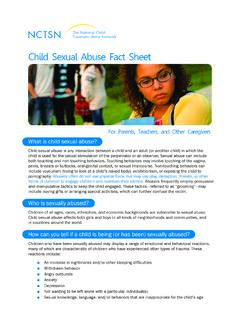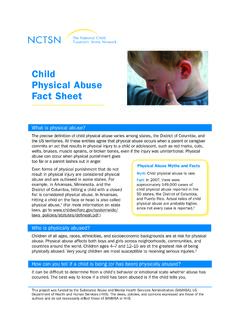Transcription of Occupational Therapy’s Role in Mental Health Promotion ...
1 Occupational Therapy's Role in Mental Health Promotion , prevention , & Intervention with children & Youth childhood trauma Did you know Occupational THERAPY PRACTITIONERS use meaningful activities to promote physical and Mental Health and well-being. Occupational therapy practitioners focus on participation in A report of a child abuse is made the following areas: education, play and leisure, social activities, activities of daily living (ADLs;. every 10 seconds ( childhelp , ). , eating, dressing, hygiene), instrumental ADLs (IADLs; , preparing meals or cleaning up, caring for pets), sleep and rest, and work. These are the usual occupations of childhood . Task Occupational Performance analysis is used to identify factors ( , motor, social emotional, cognitive, sensory) that may children who experience trauma may be challenged in limit successful participation across various settings, such as school, home, and community.
2 The following ways: Occupational therapy practitioners offer activities and accommodations within their service to Social Participation promote successful performance in these settings. Impaired social skills Increased depression, anxiety, and emotional numbing WHAT IS childhood trauma ? Over activated traumatic stress response childhood trauma is a psychologically distressing event involving exposure to actual or threat- Poor interpersonal boundaries ened death, serious injury, or sexual violence (American Psychiatric Association, 2013, p. 261). Fear of failure/hyperawareness of possible failure, leading to decreased participation in activities Such events involve a sense of fear, helplessness, and horror. childhood trauma occurs whenever ADL deficiencies (listed below) that can lead to both internal and external resources are inadequate to cope with an external threat (van der Kolk, difficulty interacting with peers ( , being teased 1989).)
3 children may experience trauma from abuse (physical, sexual, emotional), neglect (physi- about poor hygiene). History of isolation and lack of opportunity to cal, medical, emotional, educational), natural disasters, illness, and violence (school, community, interact with others domestic). Activities of Daily Living trauma exposure activates fight, flight, or freeze stress reactions, the human response to Diminished motivation to complete daily routines Difficulty managing hygiene experiences of overwhelming stress. Most children exposed to an isolated traumatic event will Difficulty controlling bladder and bowel for toileting recover in time. However, exposure to chronic interpersonal trauma ( , child maltreatment). Trouble eating ( , food hoarding behaviors) results in complex trauma , a condition that adversely affects virtually every aspect of develop- Lack of exposure to direct instruction on how to complete ADLs such as hygiene ment.
4 Complex trauma in childhood is termed developmental trauma (van der Kolk, 2005), a Fear of ADLs; abuse and neglect are frequently as- condition that presents with significantly higher levels of dysregulation (affective, physiological, sociated with locations where ADLs are completed attentional, behavioral, and relational), functional impairments, and psychiatric hospitalizations ( , bedroom, shower/bathroom). compared with children with posttraumatic stress disorder and histories of non-violent trauma Education Impaired executive function (Kisiel et al., 2014). Difficulty envisioning a future (Bloom & Yanosy- More than 3 million cases of child abuse and neglect are reported in the each year ( Sreedhar, 2008) Department of Health and Human Services [HHS], 2013) In 2013, the national rate of reported Impaired attention and arousal regulation Negative attention seeking child abuse and neglect was per 1,000 children in the national population (HHS).
5 Because Poor attendance and homework completion Occupational therapy practitioners serve young children in homes, schools, and communities, Staff or teacher not understanding the reason for they have a significant role in (1) recognizing the signs of trauma ; (2) creating safe environments negative behaviors ( What is wrong with him? vs. What happened to him? ) that support learning and development; (3) with advanced training, treating children who have Work experienced trauma ; (4) collaborating to model and facilitate skills for managing emotions for Difficulty attaining and maintaining employment the adults who serve children who are survivors of trauma ; and (5) with advanced training, col- (Bloom & Yanosy-Sreedhar, 2008). laborating with children who are survivors of trauma and the adults who serve them to develop Lack of insight with how poor self-care ( , hygiene) and social skills impact ability to be suc- skills and techniques to safely and proactively avoid crises, and to develop reactive strategies to cessfully employed safely work through crisis situations to minimize additional trauma .
6 Difficulty managing emotions to successfully navigate stressful situations Play/Leisure WHAT IS trauma -INFORMED CARE (TIC)? Decreased initiation in play and healthy leisure According to the National Child Traumatic Stress Network ( ), a trauma -informed care per- activities spective is one in which program staff, agency staff, and service providers (1) routinely screen for Over-aggressive play and bullying trauma exposure and related symptoms; (2) use culturally appropriate evidence-based assess- Frequent fear of failure and withdrawing from activi- ties ( , I quit! ) ment and treatment; (3) make resources available to children , families, and providers on trauma Sleep/Rest exposure, its impact, and treatment; (4) engage in efforts to strengthen the resilience and protec- Difficulty falling and staying asleep (Humphreys, tive factors of children and families impacted by and vulnerable to trauma ; (5) address parent Lowe, & Williams, 2009).
7 Increased occurrence of nightmares and sleep and caregiver trauma and its impact on the family system; (6) emphasize continuity of care and disturbances (Caldwell & Redeker, 2005) collaboration across systems; and (7) maintain an environment of care for staff that addresses, Increased bed wetting (Humphreys et al., 2009) minimizes, and treats secondary traumatic stress, and that increases staff resilience. This information was prepared by Terry Petrenchik, PhD, OTR/L, and David Weiss, OTR/L, with contributions from AOTA's 2015 School Mental Health Workgroup. This information sheet is part of a School Mental Health Toolkit at Occupational Therapy's Role in Addressing childhood trauma Occupational THERAPY'S ROLE IN ADDRESSING childhood trauma . Occupational therapy practitioners can serve an important role in addressing trauma at the universal, targeted, or intensive levels of interven- tion.
8 They are invaluable members of the Mental Health team because of their knowledge of the cognitive, social and emotional, and sensory components of activity and its impact on behavior (Petrenchik, 2015; Petrenchik & Guarino, 2009). children who have experienced complex trauma need environments and opportunities to regain a sense of personal safety, competence, and pleasurable connection to others. Safety, predictability, and fun are essential ingredients for helping a child to be in the moment . where all learning, skill development, and healing happen (van der Kolk, 2005). Because Occupational therapy practitioners have specialized training in task analysis and environmental modification, they can optimize the child-environment-occupation fit to enable successful activ- ity engagement and social participation. Traumatized children have difficulties handling emotions, sensations, stress, and daily routines.
9 They often feel hopeless, worthless, and incompetent (van der Kolk, 2005). Occupational therapy practitioners work with other disci- plines to structure environments, teach cognitive strategies, and develop social and emotional skills that promote self-regulation, competence development, trust building and confidence, and Occupation-based strategies could resilience through participation. include: Promotion Making activities and routines Raise awareness about the occurrence and impact of child trauma . predictable Create a culture of nonviolence through promoting positive behaviors. Helping children regain control by Foster children 's interests in healthy and safe play and leisure occupations. allowing for choice within activities Teach children positive coping skills, relational skills, and problem-solving skills. Pairing sensory approaches with Model and teach staff and adults who serve survivors of trauma principles of emotional regu- cognitive approaches to teach lation and co-regulation.
10 children to calm their bodies and minds prevention Recognize signs and symptoms of trauma . Providing frequent positive Provide group-based interventions focused on self-regulation and sensory modulation, as reinforcements well as self-efficacy. Recommending stress Use self-awareness techniques to teach children emotional regulation strategies (see The management strategies Zones of Regulation in Check This Out!). Collaborating with clients to identify Educate parents and teachers about healthy discipline, including the use of positive behavioral goals and interventions designed supports and ways to effectively deal with crises. to empower Intensive Providing frequent direct Occupational therapists with training in trauma and sensory-based interventions are qualified to: instruction and modeling to create ongoing competence and success Provide trauma -informed sensorimotor arousal regulation interventions in collaboration with Mental Health professionals (see LeBel & Champagne, 2010; Warner, Spinazzola, West- Collaborating and modeling cott, Gunn & Hodgdon, 2014;).
